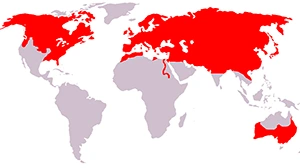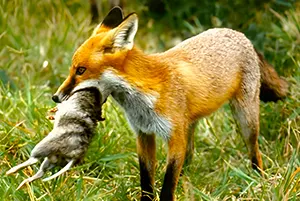Red Fox in Australia

Contents
What is a Red Fox?
The Red Fox, also known as the European Red Fox and Feral Fox is a clever medium-sized omnivore with reddish fur, large ears, yellow eyes with vertical cat-like pupils and a bushy, white-tipped tail. It is 90-105 cm (36-42 inches) in length from nose to tail and weighs 5-6 kg. Red foxes are expert hunters, climbers, and burrowers. While classified as nocturnal animals, they are actually crepuscular, meaning that they are most active during the evening and early mornings. The red fox is a solitary animal and may travel up to 15 kilometres within its home range in a single foray. Foxes can also run at speeds of up to 48 kph (30 mph), a great asset in catching prey.

Photo: Red fox standing
The red fox is a member of the Canidae family, which also includes wolves, coyotes, jackals, dingoes, and domestic dogs. It also shares many characteristics with cats, such as cat-like eyes and whiskers, retractable claws, climbing trees, and being mainly active at night. The red fox's scientific name is Vulpes vulpes.
In Australia red foxes also called Feral Foxes and European Red Foxes. These wild foxes kill large numbers of native Australian animals and have been responsible for the extinction of many Australian animals and are classified as a pest. Foxes alone kill about 300 million native animals a year in Australia.
Red Fox Sounds
Foxes are highly vocal animals with over 28 distinct sounds, ranging from sharp barks to blood-curdling screams. These vocalizations are used for communication, especially during mating or territorial disputes. In the quiet of the Australian bush, these calls can sound startling and are sometimes mistaken for owls or human screams.
Can Red Foxes Climb Trees?
Yes, they can—and do. Agile and lightweight, red foxes use their strong hind legs with flexible ankles and semi-retractable claws to climb trees in search of eggs, birds, or small mammals like possums and even baby koalas.
Where Do Red Foxes Live?

Photo: Global red fox habitat map
Although native to the Northern Hemisphere, the red fox has adapted to nearly every Australian landscape, including:
• Arid deserts
• Alpine highlands
• Farmland
• Forests
• Coastal areas
• Suburban backyards
They are absent only from tropical rainforests and the island of Tasmania.
A fox’s territory can range from 2 to 5 square kilometres, and they establish multiple dens for rest and raising their young. Foxes mark their territory with urine, scats (droppings), and secretions from their anal glands. They defend their territories with both aggressive and non-aggressive gestures and vocalizations.
Red Fox Diet & Hunting

Photo: Fox pouncing on its prey
Foxes are opportunistic predators with indiscriminate eating habits. Their diet includes:
• Native birds and mammals (quokkas, wallabies, bilbies, bandicoots)
• Reptiles (lizards, snakes)
• Insects and frogs
• Fruits, berries, and grubs
• Farm animals (poultry, lambs)
• Human food waste.

Photo: Fox chasing a rabbit
They consume about 0.5 kg of food per day. But often engage in surplus killing, slaughtering more than they can eat. This unnecessarily killing of additional animals beyond their immediate dietary requirements, has contributed significantly to the decline of many native animal populations.
Red Fox Reproduction & Life Cycle
Female foxes, also known as vixens, breed once a year between June and July, and gives birth to 4–6 kits after a gestation of 53 days. Kits remain in the den for about two months and become independent at around nine months, ready to establish territories of their own. Young foxes reach sexual maturity in 9-10 months and are ready for the next mating season.
The average life span of a red fox is between 2 to 3 years.
How the Red Fox Came to Australia

Photo: Fox hunting in the 1800s
The European red fox (Feral foxes) was first introduced on the island of Tasmania, Australia in 1833 for the elite pastime of fox huntings. But they failed to establish on the island because the native Tasmanian Devil, likely out-competed the fox and kept them in check.
In 1855, foxes were again introduced, this time to mainland Australia near Melbourne, by wealthy pastoralists for the sport of fox hunting. In 1871, additional foxes were released in Geelong and Ballarat. Unfortunately, this time the foxes adapted to their new environments and thrived.
Tasmanian Devil Outfoxed the Fox

The fox has never established itself in Tasmania. It seems that the more aggressive Tasmanian Devil found there outfoxed the fox by out-competing it as a hunter and scavenger, including digging up and consuming the fox's cached food supply. This is a rare example where a native Australian animal has succeeded against an introduced one.
Red Fox Spreads Across Australia
Foxes spread rapidly throughout the Australian mainland. and by 1912, they had spread to every state on mainland Australia. Their expansion closely matched the spread of the European rabbit, another introduced animal released in Geelong, Victoria, in 1859 for the purpose of hunting.
Foxes followed rabbits as a primary food source, and humans often intentionally released foxes into new areas, unknowingly turning the continent into a hunting ground with few natural defences.
Today, Australia is home to over 7.5 million feral foxes.
Red Fox Impact on Native Australian Wildlife

Photo: Fox with its pry - a bandicoot
Foxes are one of the greatest threats to Australian wildlife, especially to:
• Ground-dwelling birds like the night parrot
• Small mammals such as wallabies, bettongs, bilbies, and quokkas
• Rare reptiles and amphibians
They have been directly linked to the extinction of more than 20 native species including the Desert rat-kangaroo and threaten at least 76 more.
Because of its destructive nature, the European red fox has been declared an invasive species, pest, and vermin in Australia.
10 Fascinating Red Fox Facts
- Even though a fox is related to wolves and dogs, it has more in common with a cat.
- It has spines on its tongue to clean itself, can retract its claws, has prominent whiskers and vertical pupils.
- Foxes can make around 28 different sounds.
- A group of foxes is called a skulk, leash or earth.
- The fox hunts alone and can hear prey up to 35m away.
- A fox's pounce is known as 'mousing'.
- Foxes use the earth's magnetic field to judge the distance and direction of their prey.
- In Australia, adult foxes have no native predators.
- The fox threatens the survival of 76 species of native Australian animals.
- It is considered a pest, causing $227.5 million per year in economical and environmental damage.
Foxes and Australia’s Other Introduced Species
The fox isn't alone. Australia also contends with other invasive species like:
• Rabbits
• Cats
• Cane toads
• Camel
All Rights Reserved. (Last Updated: Apr 07, 2025)
